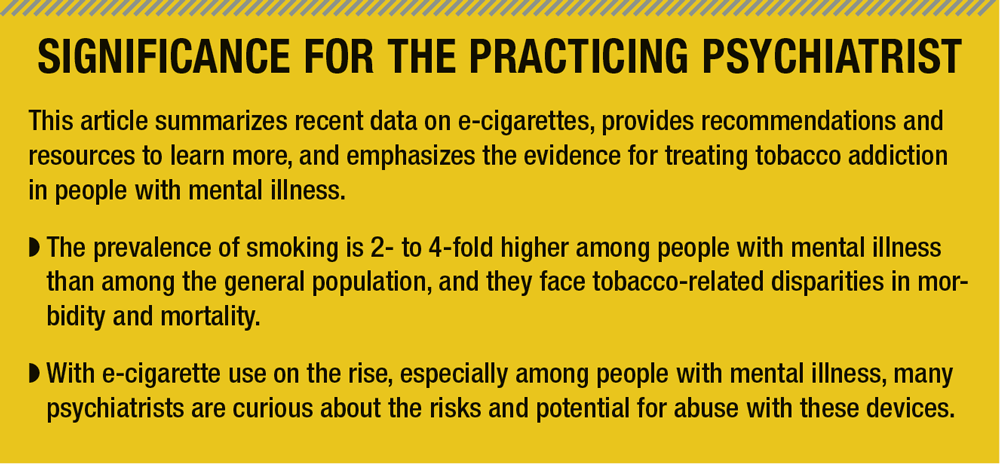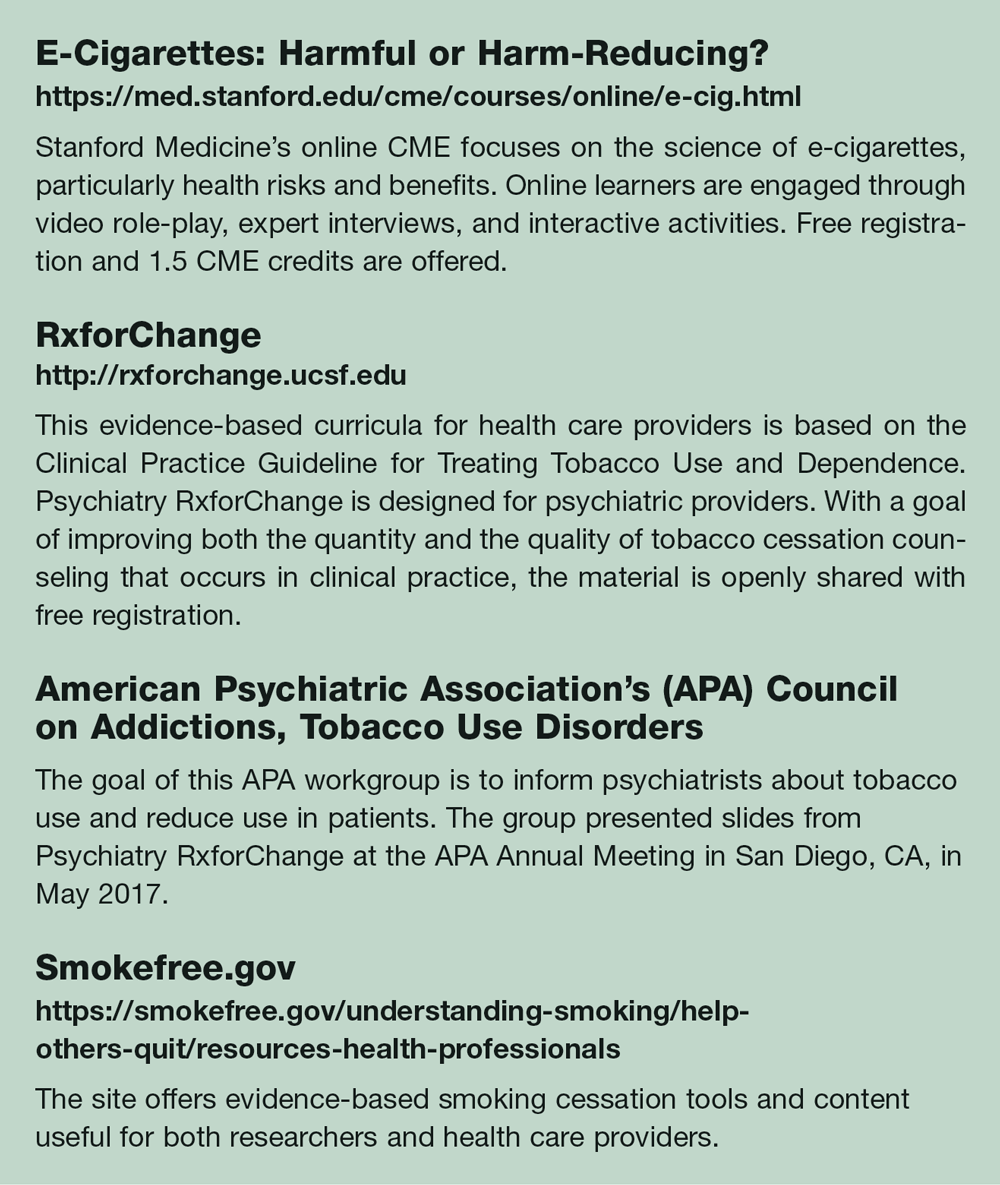Publication
Article
Psychiatric Times
E-Cigarettes, Vaping, and Other Electronic Nicotine Products: Harm Reduction Pathways or New Avenues for Addiction?
This article summarizes data on e-cigarettes, provides recommendations and resources to learn more, and emphasizes the evidence for treating tobacco (traditional cigarettes) addiction in people with mental illness.
GianlucaRasile/Shutterstock

Significance for the Practicing Psychiatrist

E-Cigarettes: Harmful or Harm-Reducing?

clinical scenario: During a routine return medication visit, your patient, a 45-year-old man with bipolar disorder, asks you about using an e-cigarette. You recall that he is a pack-a-day smoker, and when you last discussed his smoking about a year ago, he wanted to quit.
This clinical scenario is increasingly common for psychiatrists. Among people with mental illness, 15% have tried e-cigarettes compared with 7% of the general population, and use rates are on the rise.1 In a study comprising 956 cigarette smokers hospitalized for mental illness, trial use of e-cigarettes went from 0% in 2009 to 25% in 2013.2 In the general US population, among smokers, lifetime use of e-cigarettes increased from 10% in 2010 to 37% in 2013.3
Given the disproportionate burden of tobacco health harms in psychiatric patients, e-cigarettes are being considered as a potential tool for harm reduction. This article summarizes recent data on e-cigarettes, provides recommendations and resources to learn more, and emphasizes the evidence for treating tobacco (traditional cigarettes) addiction in people with mental illness.
E-cigarettes defined
E-cigarettes (ie, vaporizers, vape pens, e-hookah) are battery-operated devices that generate an aerosol from an e-liquid for inhalation. Consisting of a metal tube resembling a traditional cigarette, a battery, an atomizer, and a replaceable cartridge, e-cigarettes usually contain liquid nicotine, propylene glycol (an irritant in antifreeze), glycerin, flavoring, and other chemicals. A user puffs on an e-cigarette, and the heating element aerates the cartridge solution. Many of these are intended to simulate a cigarette. Tank or open systems, discussed below, allow users to fill the device with any substance of choice.
Developed and commercialized in China in 2003, e-cigarettes entered the US market in 2006; however, tobacco companies such as Philip Morris have been researching precursors to e-cigarettes since 1990. Over the past decade, advertising and sales of e-cigarettes have increased exponentially every year, and the major tobacco retailers now dominate the market. While tobacco advertising has been banned from television and radio since 1970, e-cigarettes are promoted widely on these media channels, on the web, and in social media, with many ads reaching youth. In August 2016-10 years after entering the US market-e-cigarettes came under the regulatory authority of the FDA, but regulatory evaluations of the products are still in progress.
E-cigarette concerns
Nicotine exposure. Nicotine is a psychoactive drug that can be addictive. Nicotine delivery with e-cigarettes varies by device (greater with the tank systems than with the cigarette-like products) and by experience level of the user. As the technology improves, the speed and the amount of nicotine absorbed are likely to increase over time, along with addiction. Mislabeling has been found with nicotine present in products labeled as nicotine-free or at higher concentrations than labeled.4
Flavors and appeal to youths. Flavored options (eg, candy, alcohol, unicorn vomit) can appeal to youth, whose brains are vulnerable to early addiction exposure. E-cigarettes are widely available for purchase online, in convenience stores, and in neighborhood vape shops. Past-month e-cigarette use nearly tripled from 2013 to 2014 among high school students (4.5% to 13.4%), surpassing all other tobacco use.5 For the first time in decades, the percentage of US youth exposed to any nicotine product increased, from 2013 to 2014 and again from 2014 to 2015. Moreover, e-cigarettes may be a gateway to conventional smoking. Two studies of adolescents who were never-smokers at baseline found that e-cigarette use predicted greater risk of cigarette smoking at follow-up.6,7
Vaping other substances. Modifications to e-cigarettes (“mods”) and open tank systems allow users to vape other substances, most commonly cannabis oil. In an anonymous study of more than 7000 high school students, nearly 1 in 5 adolescents who use e-cigarettes reported using the device to vape cannabis oil.8
Toxicity and poisoning risks. Nicotine in high doses, especially in children, can be dangerous and even fatal. Poison control calls for nicotine poisoning have increased from one call in September 2010 to 215 calls per month related to e-cigarette exposure in February 2014.9
E-cigarettes: harm reducing?
Combustible cigarettes kill two-thirds of long-term smokers.10 E-cigarettes do not involve combustion; therefore, if a smoker switches to e-cigarettes, carbon monoxide exposure and health harms will be reduced. Yet, the evidence regarding e-cigarettes as a cessation aid is limited; dual use with combustible cigarettes is common; and the safety of e-cigarettes has not been established.
Half of current smokers report regular use of e-cigarettes.11 Any use of cigarettes is harmful, and the concern is that individuals who use e-cigarettes will continue to smoke conventional cigarettes rather than quit. The strongest evidence in support of e-cigarettes for quitting smoking has come from observational studies in the UK. One study, a time-trend analysis, concluded that for every 1% increase in e-cigarette use, the success rate of quit attempts increased by 0.098%.12 In contrast, a second study in the UK found that daily use of e-cigarettes was associated with increases in quit attempts and reductions in number of cigarettes smoked, but not with smoking cessation.13
Meta-analyses have been conducted to synthesize the findings in the literature. A systematic review of 20 controlled studies concluded that the odds of quitting cigarettes was 28% lower in those who used e-cigarettes than in those who did not use e-cigarettes.14 Observational designs are challenged by confounding variables related to who self-selects to use an e-cigarette. Only 2 randomized controlled trials have evaluated e-cigarettes as a method for quitting conventional cigarettes. The quality of evidence was judged to be low grade, and in both trials, e-cigarettes with nicotine were no different in efficacy for quitting smoking than placebo (nicotine-free) e-cigarettes.15 To date, research does not support the use of e-cigarettes for cessation.
The American Heart Association’s (AHA) policy statement on e-cigarettes does not recommend their use; however, if a patient has tried and failed evidence-based tobacco cessation methods or is unwilling to try them, the AHA recommends16:
• No dual use of traditional cigarettes with e-cigarettes
• That a quit date is also set for the e-cigarettes
Tobacco and mental illness
Smokers with mental illness consume nearly half the cigarettes sold in the US and die on average 25 years earlier than the general population, largely from chronic diseases, most tobacco-related. Tobacco use also creates a significant economic burden on patients, increases isolation, and affects the metabolism of a number of psychiatric medications.
Despite the obvious need to treat tobacco addiction, there has been a historic reluctance to do so out of concerns that mental health functioning may worsen with cessation. In a 2007 AAMC (Association of American Medical Colleges) Survey of more than 3000 physicians, psychiatrists were the least likely to address tobacco addiction-although findings indicate that psychiatric outcomes improve with tobacco cessation.17,18 The tobacco industry also plays a role by promoting the self-medication hypothesis (ie, that cigarettes reduce psychiatric symptoms). However, cigarettes reduce withdrawal symptoms of nicotine rather than psychiatric symptoms. Symptoms of nicotine withdrawal can mimic psychiatric symptoms (depression, insomnia, irritability, anxiety, restlessness).
In contrast to the unknowns regarding e-cigarettes, there are evidence-based and well-established cessation treatments that are underutilized.
Smoking cessation treatment
Cessation pharmacotherapy. There are 7 FDA-approved nicotine replacement therapies (NRTs) that significantly improve quit rates: 3 over-the-counter NRTs (patch, gum, lozenge); 2 prescription NRTs (spray, inhaler); and 2 oral pills (bupropion, varenicline). NRT reduces nicotine cravings and withdrawal without the reinforcing effects of smoked nicotine. It is important to educate the patient on the proper use of NRTs. For example, people use the gum like normal chewing gum, when in fact nicotine in the gum is best absorbed in the oral mucosa by parking the gum in the cheek.
Bupropion is well known in psychiatry and acts on dopamine, norepinephrine, and nicotinic-cholinergic receptors to decrease cravings and withdrawal symptoms. Varenicline is a partial agonist at the α4β2 neuronal nicotinic acetylcholine receptor; it relieves craving and withdrawal and reduces the reinforcing effects of nicotine by blocking dopaminergic stimulation. The best evidence is for varenicline and combination NRT (eg, a patch plus gum or lozenge). The choice of medication depends on history, patient input, cost, previous attempts, and severity of dependence/withdrawal and breakthrough symptoms.
Cessation counseling. Cessation medications are most effective when combined with counseling. Integrating the Public Health Service guidelines of the 5 As-Ask, Advise, Assess, Assist, Arrange-into regular practice for treating smoking is an evidence-based approach. The AAR method is also effective and takes less than 5 minutes: Asking about smoking, Advising to quit, and Referring to a program.
The national toll-free quit line (1-800-QUIT-NOW) and the National Cancer Institute’s smokefree.gov website offer evidence-based resources. For patients who are not yet ready to quit smoking, empathy and a focus on the benefits of quitting (health, financial, social) are recommended to maintain rapport and raise motivation.
Best practices
In the clinical scenario presented at the start, the psychiatrist had not inquired about tobacco use for a year. It is recommended that psychiatrists assess tobacco use at every visit. Since tobacco use can affect clinical presentation (withdrawal symptoms) and medication levels, asking about tobacco use is clinically indicated. Systems changes (eg, including tobacco use in a standard assessment, providing clinician prompts) can help integrate tobacco treatment within clinical practice. Furthermore, supporting a culture of health where facilities are smoke-free fosters the best outcomes for smoking cessation. Smoke breaks should not be promoted nor should clinicians engage in smoking with patients. Treating patients with empathy and encouraging the use of NRT can be extremely helpful.
The Sidebar highlights 3 evidence-based accessible clinician resources on e-cigarettes and tobacco cessation treatment. We encourage psychiatrists and other mental health care providers to continue to follow the growing fields of research and regulation on e-cigarettes and tobacco.
Acknowledgments: Dr. Prochaska’s research is funded by the NCI (grant R01CA204356), the NHLBI (grant R01HL117736), and the TRDRP (grants 24RT-0035 and 25IR-0032).
This article was originally published on June 30, 2017 and has since been updated.
Disclosures:
Dr. Das is Clinical Assistant Professor, Department of Psychiatry and Behavioral Sciences, Stanford University School of Medicine; Dr. Prochaska is Associate Professor of Medicine at the Stanford Prevention Research Center, Stanford University School of Medicine, Stanford, CA.
Dr. Prochaska has been a consultant for Pfizer, which makes smoking cessation medications, and has been an expert witness for plaintiffs’ counsel in court cases against the tobacco companies.
References:
1. Cummins SE, Zhu SH, Tedeschi GJ, et al. Use of e-cigarettes by individuals with mental health conditions. Tob Control. 2014;23(suppl 3):48-53.
2. Prochaska JJ, Grana RA. E-cigarette use among smokers with serious mental illness. PloS One. 2014;9:e113013.
3. King BA, Alam S, Promoff G, et al. Awareness and ever-use of electronic cigarettes among U.S. adults, 2010-2011. Nicot Tobac. 2013;15:1623-1627.
4. Goniewicz ML, Gupta R, Lee YH, et al. Nicotine levels in electronic cigarette refill solutions: a comparative analysis of products from the U.S., Korea, and Poland. Int J Drug Policy. 2015;26:583-588.
5. Leventhal AM, Strong DR, Kirkpatrick MG, et al. Association of electronic cigarette use with initiation of combustible tobacco product smoking in early adolescence. JAMA. 2015;314:700-707.
6. Miech R, Patrick ME, O’Malley PM, Johnston LD. E-cigarette use as a predictor of cigarette smoking: results from a 1-year follow-up of a national sample of 12th grade students. Tobac Control. January 2017; Epub ahead of print.
7. Morean ME, Kong G, Camenga DR, et al. High school students’ use of electronic cigarettes to vaporize cannabis. Pediatrics. 2015;136:611-616.
8. Rigotti NA. e-Cigarette use and subsequent tobacco use by adolescents: new evidence about a potential risk of e-cigarettes. JAMA. 2015;31:673-674.
9. Chatham-Stephens K, Law R, Taylor E, et al. Exposure calls to US poison centers involving electronic cigarettes and conventional cigarettes: September 2010 to December 2014. J Med Toxicol. 2016;12:350-357.
10. Pirie K, Peto R, Reeves GK, et al. The 21st century hazards of smoking and benefits of stopping: a prospective study of one million women in the UK. Lancet. 2013;381:133-141.
11. Population Assessment of Tobacco and Health (PATH) Study Public-Use Files. Inter-University Consortium for Political and Social Research (ICPSR). 2017. http://doi.org/10.3886/ICPSR36498.v3. Accessed April 28, 2017.
12. Beard E, West R, Michie S, Brown J. Association between electronic cigarette use and changes in quit attempts, success of quit attempts, use of smoking cessation pharmacotherapy, and use of stop smoking services in England: time series analysis of population trends. BMJ. 2016;354: i4645.
13. Brose LS, Hitchman SC, Brown J, et al. Is the use of electronic cigarettes while smoking associated with smoking cessation attempts, cessation and reduced cigarette consumption? A survey with a 1-year follow-up. Addiction. 2015;110:1160-1168.
14. Kalkhoran S, Glantz SA. E-cigarettes and smoking cessation in real-world and clinical settings: a systematic review and meta-analysis. Lancet Respir Med. 2016;4:116-128.
15. Hartmann-Boyce J, McRobbie H, Bullen C, et al. Electronic cigarettes for smoking cessation. Cochrane Database Syst Rev. 2016;9:CD010216.
16. Bhatnagar A, Whitsel LP, Ribisl KM, et al. Electronic cigarettes: a policy statement from the American Heart Association. Circulation. 2014;130: 1418-1436.
17. American Association of Medical Colleges. Physician behavior and practice patterns related to smoking cessation, summary report. Washington, DC: Association of American Medical Colleges; 2007.
18. Hall SM, Prochaska JJ. Treatment of smokers with co-occurring disorders: emphasis on integration in mental health and addiction treatment settings. Ann Rev Clin Psychol. 2009;5:409-431.






